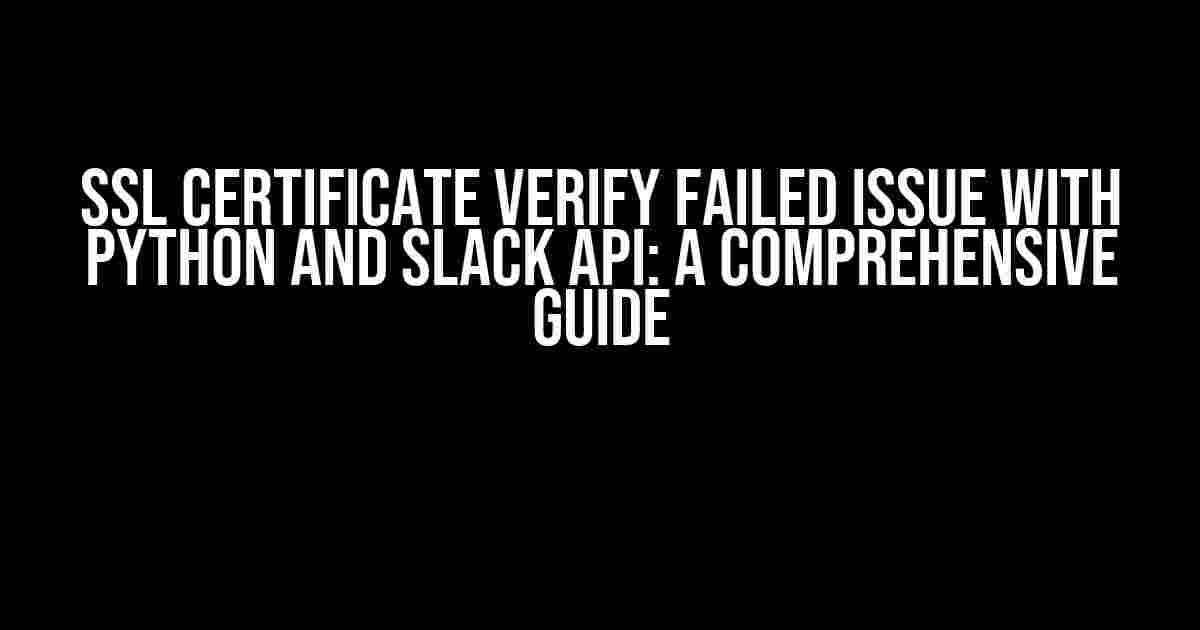Are you tired of encountering the frustrating “SSLCertificateVerifyFailed” issue while trying to interact with the Slack API using Python? You’re not alone! This dreaded error can be a major roadblock for developers, causing headaches and wasted hours. But fear not, dear reader, for we’re about to embark on a journey to conquer this beast and emerge victorious!
What is the SSLCertificateVerifyFailed Issue?
The SSLCertificateVerifyFailed error occurs when the Python script fails to verify the SSL certificate presented by the Slack API. This typically happens when the API’s certificate is not trusted or is self-signed, causing Python’s ssl module to raise an exception.
Why Does it Happen?
There are several reasons why this issue might arise:
- Self-signed certificates: Slack may be using a self-signed certificate, which is not trusted by default.
- Expired or invalid certificates: The Slack API’s certificate might have expired or be invalid, causing verification to fail.
- Custom certificates: Some organizations may use custom certificates for their Slack instances, which can cause verification issues.
- Network configuration: Firewalls, proxies, or other network configurations can interfere with the SSL connection.
Solutions to the SSLCertificateVerifyFailed Issue
Enough chit-chat! Let’s dive into the solutions to overcome this pesky issue:
1. Disable SSL Verification (Not Recommended)
The easiest, but least recommended, solution is to disable SSL verification altogether. This is a security risk, as it allows man-in-the-middle attacks. However, if you’re working in a development environment and just need to get things moving, you can use the following code:
import ssl
ssl._create_default_https_context = ssl._create_unverified_context
Warning:** This approach is not recommended for production environments!
2. Use the ssl Module’s VERIFY_NONE Option
A slightly better approach is to use the ssl module’s VERIFY_NONE option. This will allow the connection to proceed, but will still raise a warning:
import ssl
context = ssl.create_default_context()
context.check_hostname = False
context.verify_mode = ssl.CERT_NONE
While this approach is still not ideal, it’s better than completely disabling verification.
3. Use a Custom SSL Context with a Trusted Certificate
A more secure solution is to create a custom SSL context with a trusted certificate. You can do this by:
import ssl
import certifi
context = ssl.create_default_context(cafile=certifi.where())
This approach uses the certifi library, which provides a set of trusted certificates. By adding these certificates to the SSL context, you can ensure that the connection is verified correctly.
4. Use a Third-Party Library (e.g., requests)
Sometimes, using a third-party library like requests can simplify the process. The requests library has built-in support for SSL verification:
import requests
response = requests.get('https://slack.com/api/ endpoint', verify=True)
In this case, the verify=True parameter ensures that the SSL certificate is verified.
5. Check Your Network Configuration
If none of the above solutions work, it’s possible that your network configuration is interfering with the SSL connection. Check your firewall, proxy, and DNS settings to ensure they’re not blocking the connection.
Troubleshooting Tips
If you’re still struggling with the SSLCertificateVerifyFailed issue, try the following troubleshooting tips:
- Check the Slack API’s SSL certificate: Use tools like OpenSSL or
curlto inspect the API’s SSL certificate. - Verify your Python version: Ensure you’re running a supported version of Python (e.g., Python 3.7+).
- Check your Python environment: Verify that your Python environment is correctly set up, including any necessary dependencies.
- Review your code: Double-check your Python code for any syntax errors or logic issues.
Conclusion
The SSLCertificateVerifyFailed issue can be a frustrating obstacle, but with the right approaches and troubleshooting tips, you can overcome it. Remember to prioritize security and use trusted certificates to ensure the integrity of your application. By following this guide, you’ll be well on your way to successfully interacting with the Slack API using Python.
| Solution | Description | Recommended |
|---|---|---|
| Disable SSL Verification | Disables SSL verification altogether | No |
Use ssl Module’s VERIFY_NONE Option |
Allows connection to proceed, but raises a warning | No |
| Use a Custom SSL Context with a Trusted Certificate | Creates a custom SSL context with a trusted certificate | Yes |
Use a Third-Party Library (e.g., requests) |
Uses a third-party library with built-in SSL verification | Yes |
| Check Your Network Configuration | Checks for network configuration issues | Yes |
Remember, security should always be your top priority when working with APIs and SSL certificates. By following best practices and using trusted certificates, you can ensure the integrity of your application and protect your users’ data.
Frequently Asked Question
Are you tearing your hair out because of the infamous “SSLCertificateVerifyFailed” issue when trying to connect to the Slack API using Python? Worry not, friend! We’ve got you covered. Below are some frequently asked questions and answers to help you troubleshoot this pesky problem.
What is the “SSLCertificateVerifyFailed” error, and why does it occur?
The “SSLCertificateVerifyFailed” error occurs when the SSL/TLS certificate presented by the server (in this case, the Slack API) cannot be verified. This often happens when the certificate is self-signed, has expired, or hasn’t been properly installed. Python’s `ssl` module will raise this exception when it encounters such an issue. To resolve this, you need to ensure the certificate is valid, or configure your Python script to ignore certificate verification (not recommended).
How can I troubleshoot the “SSLCertificateVerifyFailed” error with Python and Slack API?
To troubleshoot this issue, try the following steps: 1) Check the Slack API’s SSL certificate using tools like OpenSSL or `curl`. 2) Verify that your Python script is using the correct API endpoint and port. 3) Ensure that your Python version and SSL library are up-to-date. 4) Disable certificate verification temporarily to see if the issue persists (not recommended for production). 5) Check your firewall or proxy settings, as they might be blocking the connection.
Can I ignore the “SSLCertificateVerifyFailed” error by disabling certificate verification in Python?
Yes, you can disable certificate verification in Python, but be warned: this is a security risk! If you’re working on a development environment or a quick proof-of-concept, you can use the `ssl._create_unverified_context()` function or set `verify=False` in your `requests` library. However, this should never be used in production, as it makes your app vulnerable to man-in-the-middle attacks. Instead, focus on resolving the certificate verification issue.
Are there any Python libraries or modules that can help me handle SSL certificates and the Slack API?
Yes, there are several Python libraries that can help you handle SSL certificates and interact with the Slack API. The `requests` library is a popular choice, which provides SSL verification options. The `slack` library, which is specifically designed for interacting with the Slack API, also provides SSL verification features. Additionally, you can use libraries like `pyOpenSSL` or `cryptography` to handle SSL certificates programmatically.
How can I prevent the “SSLCertificateVerifyFailed” error from occurring in the future?
To prevent the “SSLCertificateVerifyFailed” error from occurring in the future, ensure that you’re using the latest versions of Python, the `requests` library, and the Slack API. Regularly update your dependencies and SSL certificates. When working with self-signed certificates, make sure to add them to your trusted certificate store. Finally, always prioritize security and avoid disabling certificate verification in production environments.





